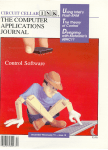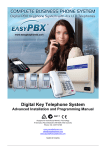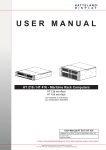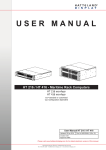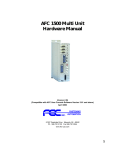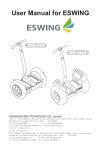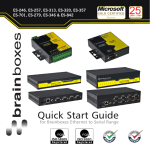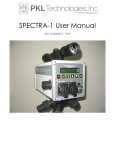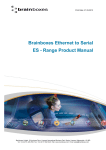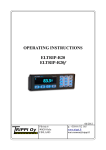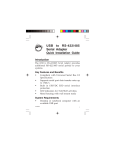Download User's Guide
Transcript
DM-280 Time Recording Terminal User’s Guide Version 1.0 July, 1999 1 DM-280 User’s Manual I. A. B. C. D. II. A. B. C. Table of Contents Introduction Page 1 Appearance Physical Description Back of Chassis RS-485 Configuration Diagram 2 2 3 3 Set-up Procedures 3 Installation Parameters: Dip Switch settings Master card : Setting Function 3 5 6 D. E. F. Temporary Card Data Print-Out ID CARD 11 12 12 III. RS-232/RS-485 Communications 13 A. B. C. D. E. F. G. H. I. IV. A. B. C. RS-232 Hardware Set-up Rs-232 Communication Parameters RS-485 Hardware Set-up RS-485 Communications Parameters Communication Data Format Examples of Conversions Command Overview RS-232/RS-485 Command Codes Control flowchart 13 14 14 15 15 16 17 17 21 23 Component of of DM280 Underside of Bottom Cover Chassis Mounted Components Connection of External Music/bell 23 24 27 V. RAM Card (optional) 28 A. Introduction 28 29 VI . TCP/IP CARD (optional) 2 I. INSTRODUCTION The DM-280 OA Timeclock records and sends employees’ entry/exit times and status to a host computer for further processing. This eliminate errors in manual data input/calculations and the redundancy of re-copying timecards. When used in conjunction with a payroll software application package, the entire time/attendance/payroll system is combined into one automatic process. Time and monetary savings are immediate. The DM-280 is a state-of-the-art computerized OA Timeclock with multi-lingual capabilities. This unit introduces the RAM card option which allows the DM-280 to be used as a stand-alone unit with an off-line capacity up to10,000 records. RAM cards are collected from each unit periodically and the data downloaded to the host computer. This avoids the costly cable installation charges and allows great flexibility. The DM-280 can use a DC12V power source (like an auto cigarette lighter) and be used where there is no electricity. (e.g. construction sites, field work, etc..) It can also use RS-232/485 interfaces. The RS-485 interface allows networkability—up to 63 units can be connected to one host on the same line. This is ideal for factories or large buildings with multiple entrances. On-line or off-line, hard copy printouts of time and status of entry/exit can be made locally by connecting with the SP-190 Audit Printer or other type printers. The DM-280 offers three types of user interfaces to suit the user need. The three options available for display are: DM-280 with a proximity reader DM-280 with a magnetic striper reader DM-280 with an IC card reader DM-280 can connect with a larger 64x128 dot matrix display for graphic images necessary in Chinese and Japanese or in other non-Roman alphabets such as Arabic, Russian, Korean, Thai, etc. It can also be used for displaying mathematical symbols or user defined graphics. This manual has been written for the model DM-280P. 3 A. APPEARANCE DM280 WITH PROXIMITY READER LCD DISPLAY Power led Keypad Proximity reader(Antenna) B. PHYSICAL DESCRIPTION OF DM-272T Display: 8 lines of 16 characters each. Keypad: 0- -9 Numeric keys 1 ‘1’ key is also used when changing parameters in master card operation # Enter key reset Reset key 4 C.BACK OF CHASSIS Wiring outlet D. RS-485 CONFIGURATION DIAGRAMS Saho RS-232-RS485 CONVETER Address: 01 Address: 02 Address:03 Address: 04 etc.. 5 II. SET-UP PROCEDURES A. Installation 1. Make sure switching power supply is 12V DC, INNER “+” 2. Open the case and adjust DIP switches as per the following page. Connect printer (if required) to J5 on main board. Place jumper-pin (SW2) top on both connectors to initiate back-up battery to keep data and clock functions in the event of a power outage. 3. Plug in power-cord. 4. If the power is in DM280, will begin a cold start process. If you are doing a warm start (DSW2 set to ON in step 2) display will begin from step 8 below. 5. DM-280 performs a selftest . Self test ... 6. If RAM is out of order, display will say so and unit will beep 3 times repeatedly. Check RAM (U4). Self test RAM(U4) ... Fail... 7. If DM-280 is in normal condition, LCD display will show Self No test ... Error 8. If RAM card is inserted in the unit, the LCD will display the size of the card which is inserted. 6 Saho DM280 V1.0 M1024 9. The unit will next run a RAM card test. If there is an error, LCD will indicate “RAM CARD ERROR”, otherwise the unit goes to next display massage. Saho RAM DM280 CARD V1.0 ERROR 10. Display shows data and time. This indicates the unit is ready. *** DM-280 *** 1999/07/01 Function 〔A〕 11. If a card is presented to DM280, the ID number of the card will be shown on the LCD Display, and stored in buffer with a long ‘beep’. At the same time, if connected, the printer will print the number and time. If a RAM card is inserted in the unit the data will be first sent to and stored in the RAM card. If the card is full, the data will be set to and stored in the DM280’s memory buffer. When the RAM card is full, LCD shows status and beeps. Remove it and replace with a new one (see RAM card section) Or retrieve it through serial communication. If there is remaining in the DM280’s buffer, the LCD will Display “MOVE DATA TO RAMCAR” and will download the data to the New card. 12. If the DM280 sounds three short beeps, it means either: Wrong operation has happened upon card presenting, e.g. wrong key was pressed before sliding. B. Parameters: Dip Switch settings Set the parameters to suit your needs via the dip switches and the Master Card functions described below. 7 Note: When DM280 is turned on, it will start at status “A”. If DSW1 #6 is set to OFF, one must press “#” (Enter) on the keypad before changing the status manually to A, B, C, or D. If it is set ON, then one need only press the status key (1, 2, 3, 4). To set hardware for RS-485 transmission, you need to use the Master card function 2(see below). Set DATA BIT to 8,PARITY to NO . DSW1 settings (DSW1) Situation 2 3 #1 Digit address Digit address RS-232 RS-485 #2 #3 #4 #5 #6 #7 ON OFF OFF ON OFF ON OFF ON Send signal to open door Doesn’t send signal to Open door ON OFF Requires pressing ‘#’ Key before changing Status Doesn’t need pressing ‘#’ before changing status Adds CR to printer OFF ON ON Doesn’t add CR to printer Printer ON OFF ON Printer OFF OFF C. MASTERCARD-SETTING FUNCTIONS FROM DM-280S KEYPAD 1. Read MASTERCARD, display shows: 1.Set timer 2.Update 3.Set #8 Param. Music 4.Clear Music 8 5.Set Func time 2. Key in 1 (2, 3, 4, 5 ) to do special function. NOTE: If any key is pressed incorrectly, DM-280 will exit this function. DM-280 will scan keyboard for 25 seconds before returning to previous menu. Programming Function 1 set time 2 set transmission mode 3 set 30 music time 4 clear all music time which have been set 5 set function 1. Set Current Time a. Read MASTERCARD and press ‘1’ key. b. Key in time (13 digits), following the format below. To change digits, first press ‘1’ key, then key in correct digits. When correct press ‘#’ key. a. year: xxxx (4 digits) b. month/date: xxxx (4 digits) c. date: xx (2 digits) d. weekday: x (1 digits) Sunday=1; Monday=1; Tuesday=2; etc. e. hour/minute: xxxx (4 digits) EG.: 1999 12 31 5 1200 1999123151230 YYYYMMDDWHHmm Press〔1〕first c. Press “1” key to modify or re-keyin before finishing entry. d. Press ‘#’ key, display will return to main menu and show the current time and date. Note: Adjustment VC1 of U2 (Real time clock IC: M6242B) for frequency correction. Use frequency counter to check IC’s pin #1 or TP1 pole. Set 9 frequency to 1.000 Hz. 2. Set Transmission Mode a. Read MASTERCARD and press ’2’ key. b. Display indicates that the transmission mode is RS-485 (see above for DSW1 settings ). To change this mode, press ‘1’ key and unit will cycle through 232 and 485. When it reaches the desired mode press ‘#’ key. (RS-485=CR-ON; Databit-8; Parity-NO.) RS- 485 c. Display next indicates the baud rate = 9600, press ‘1’ key to select the baud rate 9600, 4800, 2400, 1200. When correct press the ‘#’ key. Baud Rate RS- 9600 485 d. Display next indicates the carriage return is ON. This means record data is attached with Carriage Return (0DH) when data is uploaded. If Carriage Return is not required, press ‘1’ key. When correct press the ‘#’ key. CR Baud ON Rate RS- 9600 485 e. Display will now indicate all data attached with LF code (0AH). If line Feed is not required, press ‘1’ key. When correct press ‘#’ key. Line Feed CR Baud RS- ON ON Rate 9600 485 f. Display will next show data bit status. As this is fixed, press ‘#’ key to 10 continue. Data Bit Line Feed 8 ON CR ON Baud Rate 9600 RS- 485 g. Display will next show the parity status. If parity is not require, press ‘1’ key . Press ‘#’ key to continue. Parity Data Bit Line Feed CR NO 8 ON ON Baud Rate RS- 9600 485 h. Display will now show the ID length is 8 digits . Press ‘1’ key and key in 2 digits to change the length of ID number. The length of ID number can be from 1 to 16. When correct press the ‘#’ key. Id length Parity Data Bit Line Feed CR Baud RS- ** 08 NO 8 ON ON Rate 9600 485 If buffer already had data present, this function is disabled and user may not modify it. i. Display will now show the address code is 001. Press ‘1’ key and key in 3 digits to modify the address code. When correct press ‘#’ key. 11 Addr Id Code 001 length 08 Parity Data Bit Line Feed CR 8 ON ON Baud ** NO Rate 9600 If buffer already had data present, this function is disable and user may not modify it. j. Display will next show the file number found on valid cards. To change the file number press ‘1’ key and modify the digits. Press ‘#’ key when finished. 1234567890123456 File Id NO. 001 length 08 Parity Data Bit Line Feed NO 8 ON CR Baud ON Rate 9600 This function is reserved for magnetic stripe reader only. 3. Set 30 Music Times a. Read MASTERCARD and press ‘3’ key. Set Pess Music 〔1〕 Time first 12 b. Press ‘1’ key and key in 4 digits (2 digits for hour and 2 digits for minute). Press ‘1’ key if you make a mistake and re-do. Press ‘#’ key to store the time into memory, and key in another time if required. Set Music Time: Mon: 1230 c. Continue the procedure until the 30th music time has been set. If less than 30 music times are required, press ‘#’ two times to finish the work, DM-280 will return to main menu and the LCD will display current time. 4. Clear All Music Times Which Have Been Set a. Read MASTERCARD and press ‘4’ key. b. Display shows: Clear Music Press〔1〕 Then ? first Keyin〔#〕 c. Press ‘1’ (SELECT) key and ‘#’ (ENTER) key. 5. Set Function Key Times to Change Automatically The display of Function [A]~[D] are commonly set to signify entering and leaving workplace times and status, e.g. A= day shift in, B= day shift out, C= night shift out. These shift indicators can be set to change automatically when the appropriate time comes about. This setting can be manually overridden by simply pressing the appropriate button should one arrive late, or for other reasons. a. Read MASTERCARD and press ‘5’ key. b. Display shows “9999” which indicates that no time is presently set for function time A. 13 9999 Function 〔A〕 Press〔1〕first c. To set a time for “A” arrow to be automatically lighted press ‘1’ (SELECT) key and key in the time for it to change. Then press ‘#’ (ENTER) key. d. Display next shows function B, C, and D. Repeat procedure for b, c, and d—or just b if only two shifts are needed. Fuction 〔A〕1230 NOTE: For the beginning of a shift, the arrow must be set to enter “A” earlier than when workers begin arriving for work, e.g. set A to 8:00 if work shift start at 8:30. D. Temporary Card In case an employee forgets to bring his ID card, do as follows: 1. Present temporary card. Display will show Temorary Card: Press(1) first 2. Press ‘1’ (SELECT) key. 3. Key in the employee’s ID number. 4. Press ‘#’ (ENTER) key. Data will be stored in buffer with a long ‘BEEP’ and ID number will be displayed. Also, if connecting to a printer, it will print out this employee’s data. If wrong keys are pressed, during keying-in ID number, please press ‘1’ key to modify. E. Data print-out format If the DM-280 is connected with the SP-190 Audit Printer, or another alpha-numeric printer, the following data will be printed out upon reading a card. a. 2 digit address: A> 0100000001 12-05 10/01 14 1 2 3 4 5 1. Function status A, B, C, or D 2. 2 digit address (DSW1 #6 is OFF) 3. 8 digit ID; if number is greater than 8 digits, time and date will be printed on second row. 4. 4 digits of time 5. 4 digits month/date b. 3 digit address: A00100000001 1 2 12-05 3 4 10/01 5 All elements are the same as in 2 digit address except for #2 which now shows the three digit address. F. ID CARD 1. Present ID CARD, CARD NO. will show on DM-280’s LCD display 2. ID NO. will be printed out from printer 3. DM-280 will transmits the CARD NO. via the transmission interface. SOH + ADDRESS + ID +CHKSUM + CR (0DH) 3 2 8 1 1 EXAMPLE: Address no.=01, ID=00000003 , CHKSUM=02H 01H, 01H, 01H, 30H, 31H, 30H, 30H, 30H, 30H, 30H, 30H, 30H, 33H, 02H, 0DH III. RS-232/RS-485 COMMUNICATIONS For instructions on how to use the DM-280 on-line to your PC with the supplied software program, please consult the DM-280 Learning Kit. Below the hardware configuration and details on communication protocol necessary for programmers are explained when developing application programs. A: RS-232 Communications Hardware Set-up 1. User must make and connect a cable between PC and DM-280 as per the following specifications. Connect between T1 terminal inside DM-280 and IBM PC or compatible: Definition as follows: 15 T1 PC(D-TYPE 25 PIN) ← (RXD) PIN # 10 PIN # 2 (TXD) (TXD) PIN # 9 → PIN # 3 (RXD) (GND) PIN # 8 ← → PIN # 7 (GND) PIN # 4, # 5 shorted PIN # 6 # 20 shorted T1 PC (D-TYPE 9PIN) ← (RXD) PIN # 10 (TXD) PIN # (GND) PIN # 9 PIN # 3 (TXD) → 8 ←→ PIN # 2 (RXD) PIN # 7 (GND) PIN # 1, # 4,#6 shorted PIN # 7, # 8 shorted 2. Set DSW1: #2=OFF, #3=ON, #4=OFF. 3. RS-232 is viable up to 15.2 M (50ft.) according to EIA standards. Voltage should be +3--+15V for logic lower level. Do not exceed +25V. B. RS-232 Communications Parameters DEFAULT VALUE CONDITION MODE 16 Setting Baud rate 9600 (Selectable) Carriage return ON (Selectable) Line feed OFF (Selectable) Data bit 7 (Selectable) Parity bit No (Selectable) Id length 08 (Selectable) Address code 001 (Selectable) Communication port 232 (Fixed) File number* 1234567890123456 (Selectable) * For magnetic stripe reader only C . Hardware SetSet-up for RSRS-485 Communications 1. When using under RS-485, DSW1 should be set #2 ON, #3 OFF, #4 ON. 2. Connections between T1 terminal inside the DM-280 and IBM PC or compatible are as follows: RS-485 Converter T1 (TXD+) PIN#4 → PIN#7 (RXD+) (TXD-) PIN#5 → PIN#8 (RXD-) (RXD+) PIN#6 ← PIN#1(TXD+) (RXD-) PIN#7 ← PIN#2(TXD-) 17 *FOUR-WIRE RS-485 can convert to two-wire type by parallel TXD+/RXD+ and TXD-/RXD- respectively. 3. RS-485 is viable up to 1219m (4000ft.) according to EIA standards. Voltage should be kept from –7V--+12V. Up to 63 units (w/same communications protocol) can be on the same line to the host. 4. For use with RS-485, a converter is available from Saho which allows use of the RS-232 port on your PC. D. RS-485 Communications Parameters DEFAULT CONDITION MODE VALUE S/F Baud rate 9600 (selectable) Carriage return ON (selectable) Line feed OFF (selectable) Data bit 8 (Fixed) Parity bit NO (Fixed) Id length 8 (selectable) Address code 001 (selectable) Communication port 485 File number* (Fixed) 1234567890123456 (selectable) * For magnetic stripe reader only. E. RS-232/RS485 Communications Data Format 1. Byte Contents 7 6 5 4 3 2 1 0 The two most significant bits of each byte (bits 7 and 6) have the following definition: 00 (00H) signifies DM-280’s address 1 01 (40H) signifies DM-280’s address 2 18 10 (80H) signifies Data (data 1…data n) 11(C0H) signifies Check sum. 2. Contents of Data Packets for RS-232/RS-485 Communications The packet includes at least the following bytes: address 1 byte, address 2 bytes, data bytes and checksum byte. Each byte contains 2 bits of token (as explained above) and 6 information bits. 00 Address1 + 01 Address2 + 10 Data1 … 10 Data + 11 Checksu n m 3. Conversion Method for Data Sent from PC to DM-280 Data field byte =[(ASCII Code-20H) AND 3FH] OR 80H Example: Command ‘A’ (41H) 41H-20H =21H 21H AND 3FH=21H 21H OR 80H= 0A1H Note: Range of acceptable ASCII Code is from 20H—5FH. 4. Format for Calculating Check Code Check sum = (address 1 XOR address 2 XOR data 1 XOR…XOR data n) AND 3FH OR C0H 5. Commands The command must be placed as the first byte in the data field. 6. Format of Data Returned form DM-280 SOH SOH SOH D1 ….Dn Check Code CR SOH (Start of heading) =01H CR =0DH Check Code = D1 XOR…..XOR Dn XOR 19 (Note: if result =0DH, 0AH or 1AH the unit automatically adds 40H to prevent confusion over the end of packet.) F. Examples of RS-232/RS-485 Communications Conversions 1. Address = 01 Command A 1H, 41H, A1H, E1H Command O 1H, 41H, AFH, EFH Command C 1H, 41H, A3H, E3H Command T 1992090451200 ------------------1H, 41H, B4H, 91H 99H, 99H, 92H, 90H 90H, 94H, 95H, 91H 92H, 90H, 90H, ECH 2. Address = 02 Command A 2H, 42H, A1H, E1H Command O 2H, 42H, AFH, EFH Command C 2H, 42H, A3H, E3H Command T 1992090451200 ----------------- 2H, 42H, 99H, 92H, 90H 90H, 94H, 95H, 91H 92H, 90H, 90H, ECH A Command: Ask device state of data C Command: Receive one data record from device O Command: Increment pointer flag T Command: Set time data to device E Command: Ask time data from device M Command: Set music/alarm times K Command: Delete all music times L Command: Set times for activation of each function key S Command: Send a message to DM-280’s LCD display SOH = (01H) CR = (0DH) CHK = CHECK SUM RES = RESERVED CODE 20 91H 99H, G. Command Overview H. DM-280 RS-232/RS-485 Commands B4H, 1. A COMMAND: Ask a device the state of data HOST DM-280 Command A (41H) → ← SOH “n” (ASCII ) 3 CHK CR 1 1 1 Def: 3 digits of SOH (01H) 1 digit reply data n = 0 (30H) = Data present n = 1 (31H) = No data present 1 digit check code (format = D1 XOR…..XOR DN) 1 digit CR (0DH) 2. C COMMAND: Receive one data record from device HOST DM-280 Command C (43H) → ← SOH ADDR ID RES 3 2 or 3 8 1 TIME 4 DATA FUN 4 Def: 3 digits of SOH (0H) 2-3 digits of address. Use DSw1. #1 to set. 1—16 digits ID length. Use Mastercard function 2 to set. 1 digit reserved 4 digits time HR, Min. e.g. 1200=31H, 32H, 30H, 30H 4 digits date Mon., Date. e.g. 05 06 = 30H, 35H, 30H, 36H 1 digit function time e.g. A= 41H, B=42H, C=43H, D=44H 1 digit sequence code used to prevent duplication of data. 1 digit check code (format = D1 XOR….XOR DN) 1 digit CR (0DH) 3. O COMMAND: Increment pointer flag HOST DM-280 Command O (4FH) → 21 1 SEQ CHK 1 1 ← SOH CTL-D (04H) CHK CR 3 1 1 1 If CTL-D (0DH) is returned, pointer incremented; if no answer, failure in incrementing pointer. 4. T COMMAND : Set time data to device HOST DM-280 Command T (54H) + YYYYMMDDWHHmm→ → ← SHO “G”(47H)or “B”(42H) CHK CR 3 1 1 1 Definition of 13 digits of Date/time: YYYY= year (1993) MMDD= Month/Date (04/30) W= Day of week; 0=Sun, 1=Mon, 2=Tues. etc. HHmm= Hour/Minute (12 00) “G” (47H) = Good (successful); “B” (42H)= Bad (unsuccessful) 5. E COMMAND : Ask time data from device HOST DM-280 Command E (45H) SOH YYYYMMDDHHmm 3 CHK CR 13 1 1 6. M COMMAND: Set music/alarm times DM-280 HOST Command M+WHHmm ← SOH “G” or ”B” CHK CR 3 1 1 1 W= Day of week; 0=Sun, 1=Mon, 2=Tues. etc. , HHmm=Hour/Minute.) “G” (47H)=Good (successful); “B”(42H)=Bad (unsuccessful) 22 1 7. K COMMAND: Delete all music times HOST DM-280 Command K (48H)→ → ← SOH “G” CHK CR 3 1 1 1 “G” (47H)= Good (successful); “B”(42H)= Bad (unsuccessful) 8. L COMMAND: Set times for activation of each function key HOST DM-280 Command L (4CH)+ HHmmHHmmHHmmHHmm → ← SOH “G” or “B” CHK CR 3 1 1 1 Definition: First HHmm (4 digits) = Time (hour/min.) DM-280’s function LED will change to “A” Second HHmm (4 digits) = Time (hour/min.) DM-280’s function LED will change to “B” Third HHmm (4 digits) = Time (hour/min.) DM-280’s function LED will change to “C” Fourth HHmm (4 digits) = Time (hour/min.) DM-280’s function LED will change to “D” Response definition: “G” (47H) =Good (successful); “B”(42H) =Bad (unsuccessful) 9. S COMMAND: Show a message on DM-280’s display COMMAND S(4CH)+YXNNCCC……C Total number: NN X: LCD’s column number (hexadecimal: 0-F) Y: LCD’s row number (decimal: 0-7) NN: total number of characters (decimal: 01-99) C : required character to the DM-280 display 23 I. RS-485 Mode Control Flowcharts 24 START YES Check address 1 NO YES Check address 2 NO YES Check data NO 是 Save data in buffer temporary (Data 0 ... Data n) NO Yes Check sum DO Yes Return 25 DO NO Check command "A" yes NO Check command "C" yes NO Check command "O" NO yes Check command "T" NO Check command "E" Answer=0-1 0 data present 1 no data Set transmitting flag, return to main program & resend Check if transmitting flag is set, then delete noe data. If not set don't delete. Input 13 digits of new time yes Read current time, total of 13 digits NO Check command "M" yes Input 4 digit music times maximum of 30 sections NO Check command "K" Clear music times yes NO Check command "L" NO Check command "S" NO yes Input 4 digits of shift function time yes Display message on DM-280 Return 26 IV. COMPONENTS OF DM-280 A. Underside of bottom cover: 27 B. Chassis Mounted Components 28 CPU J1 (micro 4 pin) Barcode reader connector Pin #1 +5V (VCC) Pin #2 DATA signal Pin #3 NC Pin #4 GND J2(micro 5 pin) IC card reader connector Pin #1 +5V(VCC) Pin #2 GND Pin #3 RXD Pin #4 TXD Pin #5 INT J3 (micro 5 pin) Proximity Reader connector Pin #1 +12V (VCC) Pin #2 GND Pin #3 Reader head READY signal Pin #4 Reader head DATA signal Pin #5 Reader head CLOCK signal J4 (micro 3 pin) Power Supply input Pin #1 +12V Pin #2 NO connect Pin #3 GND J5 (micro 12 pin) Printer connector Pin #1 (STROBE) Low voltage action Pin #2—Pin #9 D0 D7 DATA BUS Pin #10 BUSY Pin #11 GND Pin #12 GND J6 (micro 5 pin) Magnetic Reader connector Pin #1 +5V (VCC) Pin #2 GND Pin #3 Reader head READY signal 29 Pin #4 Reader head DATA signal Pin #5 Reader head CLOCK signal J7 (micro 10 pin) Keyboard Interface Pin #1 input data 0 Pin #2 input data 1 Pin #3 input data 3 Pin #4 input data 4 Pin #5 output data 0 Pin #6 output data 1 Pin #7 output data 2 Pin #8 output data 3 Pin #9 reset Pin #10 GND J8 DC-JACK (Power supply input) INNER : + J9 Display connector: has a one-to-one relationship with display F1 RAM card input port. T1: Pin definitions Pin #1 +5V (VCC) Pin #2 System 5V Pin #3 GND Pin #4 RS-485 RS-422 TXD+ Pin #5 RS-485 RS-422 TXDPin #6 RS-485 RS-422 RXD+ Pin #7 RS-485 RS-422 RXDPin #8 GND Pin #9 RS-232 TXD Pin #10 RS-232 RXD Pin #11 Outside bell/music (TTL signal output) Pin #12 GND Pin #13 Outside electric lock (TTL signal output) Pin #14 GND Pin #15 TCP/IP RXD Pin #16 TCP/IP TXD 30 VR1 Adjusts backup voltage. Also connects with RESET input of CPU VC1 6242 Quartz clock adjustment. Use frequency counter to Pin #1 or TP1 terminal, then adjust to 1 Hz. DSW2 must be shorted for back-up battery (3.6V) to allow memory back-up, and for quartz clock to continue keeping time in the event of a power outage. C. Connection of External Music/bell In order to signal shift/break beginnings and endings a music/bell system should be connected to the DM-280 Time Recording Terminal. The DM-280 simply sends a TTL signal from pin #11 of the T1 terminal. User must supply his own bell or music equipment. The bell/music should be grounded on pin #12 of T1 terminal. 31 V. RAM CARD (optional) A. Introduction Note: RAM CARD is a standard PCMCIA Card, PCMCIA 2.01/JEIDA Compatible . Static Random Access Memory (SRAM) card’s maximum addressing capacity is 1024 K bit (128K) at present. On back of card is a write protect switch. Turn off before inserting in DM-280. When not in use, this switch should be set to on to protect the data from being overwritten. This RAM card requires a lithium cell (BR-2325) to save data written to the card. If the battery needs to be replaced, make sure that the new battery is the same type. Insert the lithium cell (BR-2325) before using the RAM card. Turn the card upside-down and find the groove for removing the cell holder. Pull out the holder, insert the lithium cell with the plus (+) side UP, and push the holder back into the case. CAUTION: If the plus (+) side is not facing up, data will not be saved. The DM-280 has a low-battery detection circuit for the RAM card. If the battery’s voltage is less than 2V, three beeps will sound and the LCD will display. If the RAM card’s buffer’s are full, the LCD will display. Replacing the lithium cell The life of the lithium cell depends on the amount of data in memory and usage temperatures. Cell life is shortened by high temperatures over 40°C. 32 VI . TCP/IP CARD (optional) WIRING between DM-280 and TCP/IP, DSW1 should be set #2 ON,#3 OFF, #4 ON DM280 T1 TCP/IP CARD 1 2 3 4 5 6 7 8 9 10 11 12 13 14 15 16 J4 GND TXD RXD 9 8 7 6 5 4 3 2 1 GND TXD RXD J3 GND 1 (+5V) 2 J2 GIBB-CPU-7257-2 TO HUB METHOD 1 DM280 T1 TCP/IP CARD 1 2 3 4 5 6 7 8 9 10 11 12 13 14 15 16 J4 GND TXD RXD 9 8 7 6 5 4 3 2 1 GND RXD TXD J3 GND 1 (+5V) 2 J2 GIBB-CPU-7257-2 TO HUB METHOD 2 33 34



































